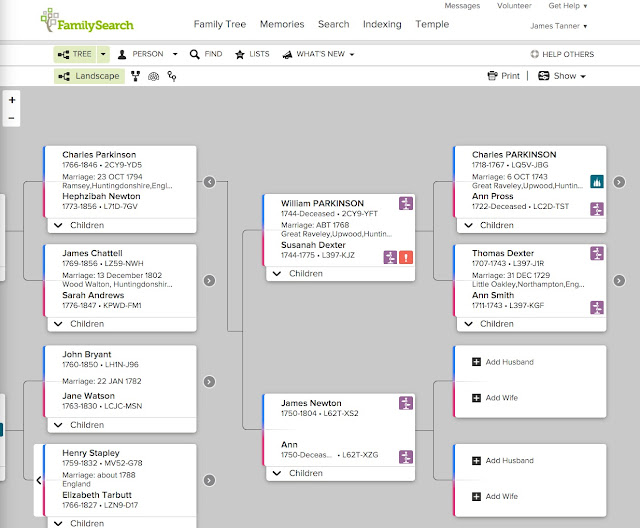As a veteran of many years of representing clients in court, I have become increasing skeptical of any factual claim. Of course, this attitude has carried over into my family history research. Lately, I have run across accounts of people who consider the entries on the
FamilySearch.org Family Tree to be the "gospel truth" for the rather simple reason that the website is sponsored, indirectly, by
The Church of Jesus Christ of Latter-day Saints. In short, they place the reliability of the entries on the same level as a religious belief. This is certainly not the position of the Church or of FamilySearch.
To have such a simplistic attitude towards the entries in the Family Tree, the user has to ignore the icons with warnings and cautions. See
Data Problems. But even taking into account these automated warnings, it is essential that anyone using the program spend some time and effort to assure that the entries are as correct and reliable as possible.
This is especially true if the user is contemplating relying on the entries back more than five or six generations. It is important to understand that as we go back on any given line, the accuracy of each successive generation depend heavily on the accuracy of all the proceeding or supporting generations. It is also important to understand that all of the information in the Family Tree came from individuals submitting the information to the Church, the Genealogical Society of Utah and FamilySearch for over 100 years. None of the information entered into the Family Tree is verified by anyone at FamilySearch or the Church.
At the initial level, you need to focus on whether or not there are any sources substantiating the information in the Family Tree. Historically, adding source citations was not emphasized so many entries lack any such citations to where the information was obtained. The bare fact of the matter is that any entry without a substantiating source citation is automatically subject to question. My own experience is that it is also necessary to review any source citations that appear. It is not uncommon that the sources do not pertain to the person to whom they are attached. It also not uncommon to find that the information in the Detail Section is different than that recorded in the sources.
Relatively recently, FamilySearch implemented a program of providing "Record Hints" for the individuals in the Family Tree. These Record Hints are limited to the indexed records in the Historical Record Collections. The more indexing that is done, the more Record Hints will be come available. I have found these Record Hints to be extremely valuable. The suggested records are not 100% applicable to the individuals, but they are accurate enough to be very useful in adding and correcting information. I strongly suggest that all Record Hints be evaluated and added where applicable. FamilySearch encourages adding all the Record Hints because that helps the program find more accurate records.
As an example, I have been systematically working back on my Parkinson line. Here is a screenshot showing how far I have gone. I am presently adding sources to the Charles Parkinson line back in the mid-1700s.
I have substantially verified the entries back to Charles Parkinson (b. 1766, d. 1846) and his wife Hephzibah Newton (b. 1773, d. 1856). when I started there were no source records for anyone of the family members past Charles' grandson, my Great-Great-Grandfather, Thomas Parkinson (b. 1830, d. 1906). The purple icons on William Parkinson and his wife indicate that there are no sources attached. As far as I am concerned, I do not consider any of the information past Charles to be reliable. In fact, Family Search has detected a situation where a child was born after the mothers' recorded birth date, hence, the red exclamation point. Here is the Detail Page for William Parkinson.

Right off, I can see a major problem. This person was not baptized (christened) on his birthday. One of these two dates is wrong. The second issue not so obvious. Could he have been christened in Great Raveley, Upwood, Huntingdon, England? In short, was Great Raveley a parish? I ask this question because of the use of the word "Huntingdon." Huntingdon is a market town. Upwood is also a town in Huntingdonshire. So for the birth and christening place we have the names of three different towns. The county is Huntingdonshire. It is mistakes like this that make me question the accuracy of any of the entries. Do we even have the right person considering we are back into the mid-1700s?
As I already mentioned, there are no source attached to this person, so I am forced to search for sources to verify the information. If I were to simply assume that "everything in the Family Tree is correct," I would be way off base with this entry.
I will begin my search in the FamilySearch Catalog. I immediately find that there are entries for the following in England, Huntingdonshire:
- Great Raveley
- Little Raveley
- Raveley (Great)
- Raveley (Little)
- Upwood
- Huntingdon
and so the investigation begins. Because of the ambiguity of the entries, I am forced to examine records for all six places. Needless to say, this correction process has been going on for years and will likely continue for more years.
The only way that the Family Tree will become a "book of all aceptation" is to make all of these changes and corrections. Meanwhile we also have to watch all of these ancestors so that our hard earned research is not erased by someone who has not spent the time to review what is already in the record.
















































